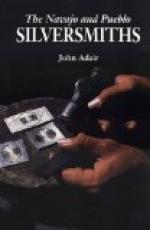NAVAJO SILVERSMITHS.
By Washington Matthews.
Among the Navajo Indians there are many smiths, who sometimes forge iron and brass, but who work chiefly in silver. When and how the art of working metals was introduced among them I have not been able to determine; but there are many reasons for supposing that they have long possessed it; many believe that they are not indebted to the Europeans for it. Doubtless the tools obtained from American and Mexican traders have influenced their art. Old white residents of the Navajo country tell me that the art has improved greatly within their recollection; that the ornaments made fifteen years ago do not compare favorably with those made at the present time; and they attribute this change largely to the recent introduction of fine files and emery-paper. At the time of the Conquest the so-called civilized tribes of Mexico had attained considerable skill in the working of metal, and it has been inferred that in the same period the sedentary tribes of New Mexico also wrought at the forge. From either of these sources the first smiths among the Navajos may have learned their trade; but those who have seen the beautiful gold ornaments made by the rude Indians of British Columbia and Alaska, many of whom are allied in language to the Navajos, may doubt that the latter derived their art from a people higher in culture than themselves.
The appliances and processes of the smith are much the same among the Navajos as among the Pueblo Indians. But the Pueblo artisan, living in a spacious house, builds a permanent forge on a frame at such a height that he can work standing, while his less fortunate Navajo confrere, dwelling in a low hut or shelter, which he may abandon any day, constructs a temporary forge on the ground in the manner hereafter described. Notwithstanding the greater disadvantages under which the latter labors, the ornaments made by his hand are generally conceded to be equal or even superior to those made by the Pueblo Indian.
A large majority of these savage smiths make only such simple articles as buttons, rosettes, and bracelets; those who make the more elaborate articles, such as powder-chargers, round beads (Pl. XVI), tobacco cases, belts, and bridle ornaments are few. Tobacco cases, made in the shape of an army canteen, such as that represented in Fig. 6, are made by only three or four men in the tribe, and the design is of very recent origin.
Their tools and materials are few and simple; and rude as the results of their labor may appear, it is surprising that they do so well with such imperfect appliances, which usually consist of the following articles: A forge, a bellows, an anvil, crucibles, molds, tongs, scissors, pliers, files, awls, cold-chisels, matrix and die for molding buttons, wooden implement used in grinding buttons, wooden stake, basin, charcoal,




